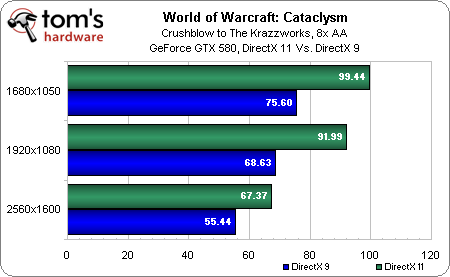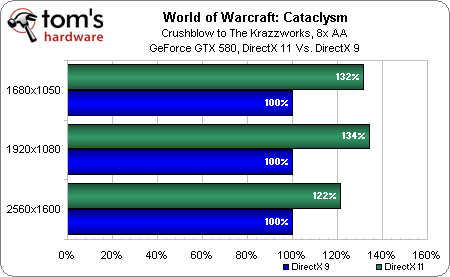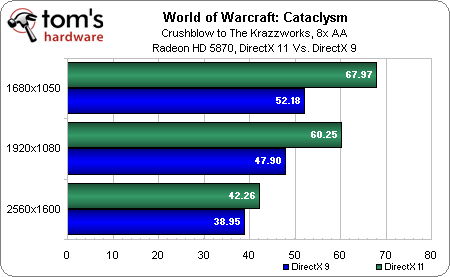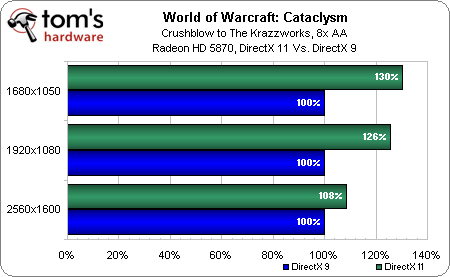World Of Warcraft: Cataclysm--Tom's Performance Guide
Ready for the launch of Blizzard's World of Warcraft: Cataclysm expansion tomorrow? Is your PC? We test 24 different graphics cards from AMD and Nvidia, CPUs from AMD and Intel, and compare DirectX 9 to DirectX 11, showing you which settings to use.
DirectX 9 Versus DirectX 11
Blizzard's World of Warcraft 3D engine is said to center on a modified Warcraft III engine, which required DirectX 8.1. With that said, World of Warcraft now employs a DirectX 9 code path, extending compatibility to a broad range of modern graphics cards dating back to 2003.
Of course, gamers get excited about subsequent versions of DirectX (or OpenGL, for that matter) because they often herald a new generation of effects and technologies developers can use to augment realism. But a new API doesn't necessarily have to center on beautiful new features; it can also introduce more efficient ways of doing things already seen today. We saw that recently with Firaxis' Civilization V, which uses DirectX 11 to help improve performance (rather than introduce new eye candy).
As it turns out, Cataclysm incorporates experimental support for DirectX 11, and rather than adding anything visually, it's designed to help speed up performance, too.
Of course, if you want to take advantage of DirectX 11, you'll need a DX11-capable card from AMD's Radeon HD 5000/6000 lineup or Nvidia's GeForce GTx 400 series. You can't enable DX11 through a graphical option. Rather, you'll need to add '-d3d11' to your World of Warcraft shortcut. Or, open your config.wtf file (located in ...\World of Warcraft\WTF\) and add the line SET gxApi "d3d11".
What sort of gains can you expect to see? Much to our surprise, they're significant.
Using a GeForce GTX 580, frame rates jump more than 30% at 1680x1050 and 1920x1080--two resolutions that are processor-bound for this fast card, not graphics-bound. Moving up to 2560x1600 cuts the gain to 22%. Though still not bad, this shows that DirectX 11's mechanisms for improving threading and memory handling can greatly speed up rendering, so long as there is not some other bottleneck limiting performance.
AMD's Radeon HD 5870 sees similar benefits as the GeForce card at 1680x1050. Because it's not as powerful, those gains erode a bit at 1920x1080 and evaporate almost entirely at 2560x1600 once the card can no longer outpace our powerful processor.
Get Tom's Hardware's best news and in-depth reviews, straight to your inbox.
In what almost seems like a stroke of irony, it looks like the folks most likely to see big speed boosts at the hands of Blizzard's DX11 code path are the ones with fast processors and near-overkill GPUs. If you built your PC with balance in mind, there shouldn't be as much room for API optimizations to augment performance beyond what you're already seeing. With that said, I've been passing this DirectX 11 flag around to a number of friends with lower-end Core i5 and Core 2 Quad configurations, and they're all seeing roughly 20 frame per second performance boosts. So long as your GPU is DirectX 11-capable, there's a fair chance that enabling Blizzard's code path will at least do something for your gaming experience.
Current page: DirectX 9 Versus DirectX 11
Prev Page Nvidia: Mainstream Cards At Good Quality Next Page AMD And Nvidia: Anti-Aliasing Performance-
Odem Kind of unfortunate to see if I had gone with an i5 750 instead of a 955 I'd be seeing more fps. Although the money I saved for the same frames in most other games leaves me happy.Reply -
WOW only uses 2 cores by default. However youc an configure it to "quasi" use more cores. you have to manually edit your config.wtf and change the variable: SET processAffinityMask "3" (3 is the default meaning 2 cores) to the following values for respective processors:Reply
i7 Qudcore with Ht- 85
Any Quadcore chips with no HT - 15
i5 Quadcore which does not have HT as far as I know - 15
i5 Dualcore with HT- 5
Dualcore with HT- 5
Dualcore without HT - 5
AMD tricore - 7
There used to be a blue post explaining the settings and how to calculate it for different cores. But the old forums got wiped. -
sudeshc not a that big fan of wow, but still happy to see that they do keep in mind that people also have low end hardware too.Reply -
SpadeM I'm impressed, if Chris went to all that trouble to benchmark the new expansion for a mmorpg in such great detail it can me only 2 things:Reply
1. Chris is a closet WoW-player
2. Really bored
With that said, i really do hope to see more of these articles, albeit with a more demanding title on the bench, even if it's from a "lesser" developer/publisher combo.
PS: I do hope ppl appreciate my sense of humor :P -
dirtmountain Damn fine job Mr. Angelini, the most comprehensive hardware guide i've ever seen for WoW. This will save me hours, if not days of time when talking to players about their systems. Much appreciated.Reply -
Bluescreendeath The Intel CPU scaling part was lacking...i7 980X at 3.7GHz? For WoW? Really?Reply
And why only Corei CPUs? Where are all the Core2s? 75% of Intel users still use Core2s and 775s! -
voicu83 i hate you so much tom's hardware ... now i have to go buy an intel proc instead of my phenom ii x4 :D ... and add a dx11 board on top of it ... oh well, there goes my santa's gift :PReply -
Moneyloo Simply astounded by the time and effort that must have went into this piece. It also makes me greatly look forward to my new Maingear desktop arriving on the 23rd just in time for Christmas. Dual OC gtx580s in sli with a corei7 FTW. Ultra everything here I come!Reply -
cangelini SpadeMI'm impressed, if Chris went to all that trouble to benchmark the new expansion for a mmorpg in such great detail it can me only 2 things:1. Chris is a closet WoW-player2. Really boredWith that said, i really do hope to see more of these articles, albeit with a more demanding title on the bench, even if it's from a "lesser" developer/publisher combo. PS: I do hope ppl appreciate my sense of humorReply
It's a little easier to talk about WoW since I've been playing it for way too long, but I definitely want to see us doing more comprehensive coverage of demanding titles on launch day. It's all a matter of trying to convince the software guys to give a hardware site early access to the game. That's the hard part :)
-
mitch074 With hardware-accelerated cursor now enabled, OpenGL has finally become usable in WoW; was there any testing done on that? Not only does it sometimes give a boost to Nvidia cards, it's also the 'default' setting for Linux players - incidentally, the ones who were asking for the feature for a while.Reply




